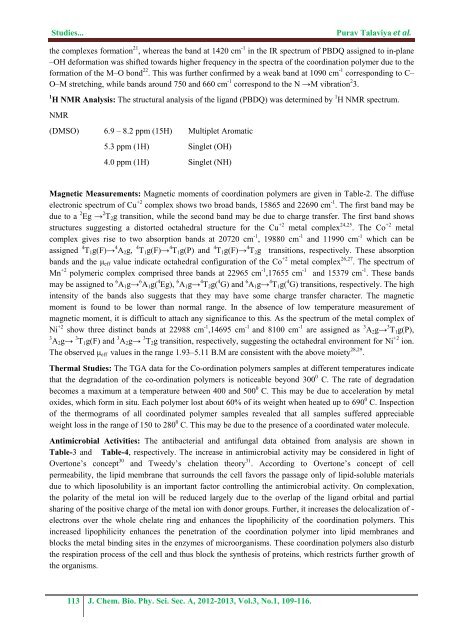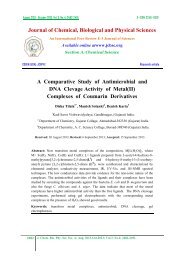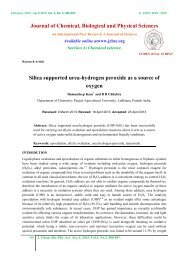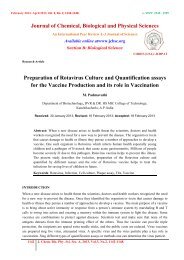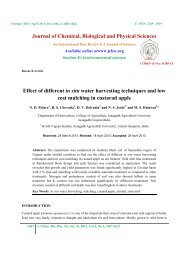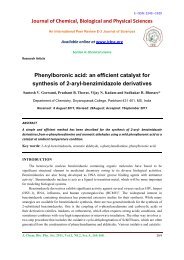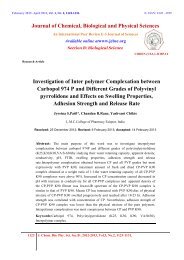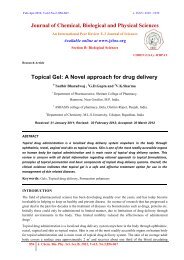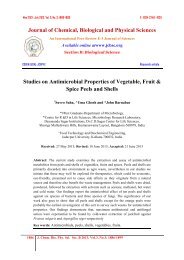Studies on Synthesis, Characterization and Antibacterial Activity of ...
Studies on Synthesis, Characterization and Antibacterial Activity of ...
Studies on Synthesis, Characterization and Antibacterial Activity of ...
- No tags were found...
You also want an ePaper? Increase the reach of your titles
YUMPU automatically turns print PDFs into web optimized ePapers that Google loves.
<str<strong>on</strong>g>Studies</str<strong>on</strong>g>...Purav Talaviya et al.the complexes formati<strong>on</strong> 21 , whereas the b<strong>and</strong> at 1420 cm -1 in the IR spectrum <strong>of</strong> PBDQ assigned to in-plane–OH deformati<strong>on</strong> was shifted towards higher frequency in the spectra <strong>of</strong> the coordinati<strong>on</strong> polymer due to theformati<strong>on</strong> <strong>of</strong> the M–O b<strong>on</strong>d 22 . This was further c<strong>on</strong>firmed by a weak b<strong>and</strong> at 1090 cm -1 corresp<strong>on</strong>ding to C–O–M stretching, while b<strong>and</strong>s around 750 <strong>and</strong> 660 cm -1 corresp<strong>on</strong>d to the N →M vibrati<strong>on</strong> 2 3.1 H NMR Analysis: The structural analysis <strong>of</strong> the lig<strong>and</strong> (PBDQ) was determined by 1 H NMR spectrum.NMR(DMSO) 6.9 – 8.2 ppm (15H) Multiplet Aromatic5.3 ppm (1H) Singlet (OH)4.0 ppm (1H) Singlet (NH)Magnetic Measurements: Magnetic moments <strong>of</strong> coordinati<strong>on</strong> polymers are given in Table-2. The diffuseelectr<strong>on</strong>ic spectrum <strong>of</strong> Cu +2 complex shows two broad b<strong>and</strong>s, 15865 <strong>and</strong> 22690 cm -1 . The first b<strong>and</strong> may bedue to a 2 Eg → 2 T 2 g transiti<strong>on</strong>, while the sec<strong>on</strong>d b<strong>and</strong> may be due to charge transfer. The first b<strong>and</strong> showsstructures suggesting a distorted octahedral structure for the Cu +2 metal complex 24,25 . The Co +2 metalcomplex gives rise to two absorpti<strong>on</strong> b<strong>and</strong>s at 20720 cm -1 , 19880 cm -1 <strong>and</strong> 11990 cm -1 which can beassigned 4 T 1 g(F)→ 4 A 2 g, 4 T 1 g(F)→ 4 T 1 g(P) <strong>and</strong> 4 T 1 g(F)→ 4 T 2 g transiti<strong>on</strong>s, respectively. These absorpti<strong>on</strong>b<strong>and</strong>s <strong>and</strong> the µ eff value indicate octahedral c<strong>on</strong>figurati<strong>on</strong> <strong>of</strong> the Co +2 metal complex 26,27 . The spectrum <strong>of</strong>Mn +2 polymeric complex comprised three b<strong>and</strong>s at 22965 cm -1 ,17655 cm -1 <strong>and</strong> 15379 cm -1 . These b<strong>and</strong>smay be assigned to 6 A 1 g→ 6 A 1 g( 4 Eg), 6 A 1 g→ 4 T 2 g( 4 G) <strong>and</strong> 6 A 1 g→ 4 T 1 g( 4 G) transiti<strong>on</strong>s, respectively. The highintensity <strong>of</strong> the b<strong>and</strong>s also suggests that they may have some charge transfer character. The magneticmoment is found to be lower than normal range. In the absence <strong>of</strong> low temperature measurement <strong>of</strong>magnetic moment, it is difficult to attach any significance to this. As the spectrum <strong>of</strong> the metal complex <strong>of</strong>Ni +2 show three distinct b<strong>and</strong>s at 22988 cm -1 ,14695 cm -1 <strong>and</strong> 8100 cm -1 are assigned as 3 A 2 g→ 3 T 1 g(P),3 A 2 g→ 3 T 1 g(F) <strong>and</strong> 3 A 2 g→ 3 T 2 g transiti<strong>on</strong>, respectively, suggesting the octahedral envir<strong>on</strong>ment for Ni +2 i<strong>on</strong>.The observed µ eff values in the range 1.93–5.11 B.M are c<strong>on</strong>sistent with the above moiety 28,29 .Thermal <str<strong>on</strong>g>Studies</str<strong>on</strong>g>: The TGA data for the Co-ordinati<strong>on</strong> polymers samples at different temperatures indicatethat the degradati<strong>on</strong> <strong>of</strong> the co-ordinati<strong>on</strong> polymers is noticeable bey<strong>on</strong>d 300 0 C. The rate <strong>of</strong> degradati<strong>on</strong>becomes a maximum at a temperature between 400 <strong>and</strong> 500 0 C. This may be due to accelerati<strong>on</strong> by metaloxides, which form in situ. Each polymer lost about 60% <strong>of</strong> its weight when heated up to 690 0 C. Inspecti<strong>on</strong><strong>of</strong> the thermograms <strong>of</strong> all coordinated polymer samples revealed that all samples suffered appreciableweight loss in the range <strong>of</strong> 150 to 280 0 C. This may be due to the presence <strong>of</strong> a coordinated water molecule.Antimicrobial Activities: The antibacterial <strong>and</strong> antifungal data obtained from analysis are shown inTable-3 <strong>and</strong> Table-4, respectively. The increase in antimicrobial activity may be c<strong>on</strong>sidered in light <strong>of</strong>Overt<strong>on</strong>e’s c<strong>on</strong>cept 30 <strong>and</strong> Tweedy’s chelati<strong>on</strong> theory 31 . According to Overt<strong>on</strong>e’s c<strong>on</strong>cept <strong>of</strong> cellpermeability, the lipid membrane that surrounds the cell favors the passage <strong>on</strong>ly <strong>of</strong> lipid-soluble materialsdue to which liposolubility is an important factor c<strong>on</strong>trolling the antimicrobial activity. On complexati<strong>on</strong>,the polarity <strong>of</strong> the metal i<strong>on</strong> will be reduced largely due to the overlap <strong>of</strong> the lig<strong>and</strong> orbital <strong>and</strong> partialsharing <strong>of</strong> the positive charge <strong>of</strong> the metal i<strong>on</strong> with d<strong>on</strong>or groups. Further, it increases the delocalizati<strong>on</strong> <strong>of</strong> -electr<strong>on</strong>s over the whole chelate ring <strong>and</strong> enhances the lipophilicity <strong>of</strong> the coordinati<strong>on</strong> polymers. Thisincreased lipophilicity enhances the penetrati<strong>on</strong> <strong>of</strong> the coordinati<strong>on</strong> polymer into lipid membranes <strong>and</strong>blocks the metal binding sites in the enzymes <strong>of</strong> microorganisms. These coordinati<strong>on</strong> polymers also disturbthe respirati<strong>on</strong> process <strong>of</strong> the cell <strong>and</strong> thus block the synthesis <strong>of</strong> proteins, which restricts further growth <strong>of</strong>the organisms.113 J. Chem. Bio. Phy. Sci. Sec. A, 2012-2013, Vol.3, No.1, 109-116.


